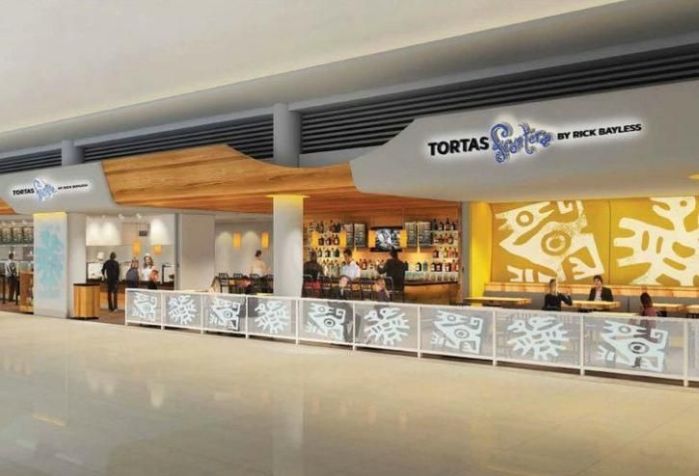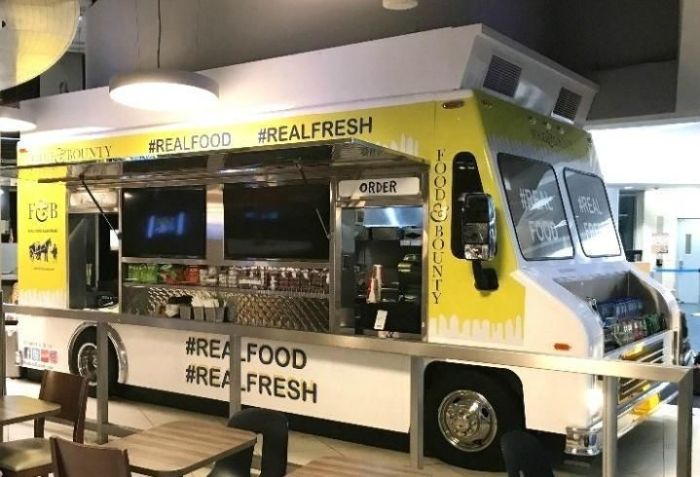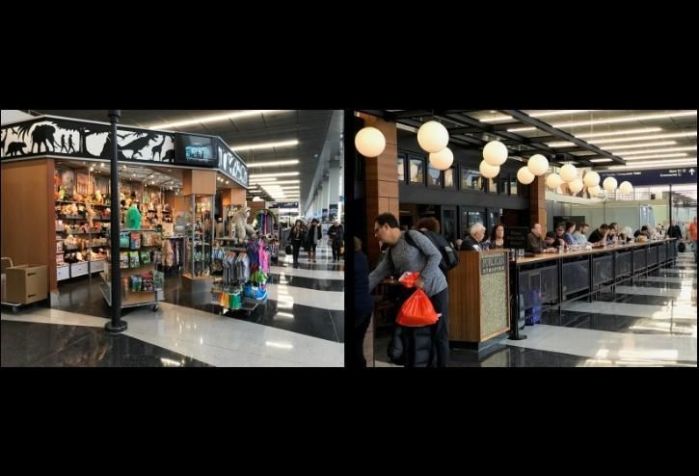The international terminal at Chicago’s O’Hare International Airport used to be a concessions wasteland of fast food, a newsstand and not much else.
Until 2011, when Westfield started a three-year, $26M renovation program that nearly doubled the terminal’s retail footprint to 30K SF and added 24 new retail and dining offerings, including a quick-service sandwich concept from James Beard award-winning chef Rick Bayless and five different restaurants from James Beard award-winning restaurateur Rich Melman.
The windfall: an 82% increase in retail sales.

Chef Rick Bayless has three Tortas Frontera quick-service casual restaurants at O’Hare International Airport, including one in O’Hare’s international terminal. Airport retailers are realizing formerly untapped potential in upgrading concessions. Food concepts have shifted over the past 10 to 15 years from bland, generic offerings, to national brands like Starbucks and Chili’s To Go, to the present day, with local restaurateurs and themes to provide a sense of authenticity.
The focus on local businesses is spurring revenue for airports while giving the captured audience in airports a taste of the city’s flavor waiting for them outside.
“Airports are mixed-use entertainment and retail centers that just happen to have planes outside,” Gensler principal Benjy Ward said. “People are more specific as to what they want in their dining options. They want ‘food theater’; they don’t want to go to Sbarro anymore.”
Lifting Pages From The Food Hall Playbook
Sudo Gensler principal Benjy Ward, Equity Office Senior Vice President David Moore and Zeller Realty Group principal Janice Goldsmith Ward said the age of the airport food court is gone. The changes to airport concessions in recent years mirror what is happening in dense urban areas and retail centers with food halls. Travelers want something that is local and fresh, which is what the concept of the food hall is all about.
Westfield’s bet on O’Hare paid off: Retail concessions there have increased 82% since the renovations were completed, and the sales per enplanement (revenue-generating passengers) have increased by more than 50% to $22.21 per person.
Westfield’s success with O’Hare epitomizes the sea change in airport concessions nationally. Denver International Airport reported over $39.5M in restaurant sales in January and February, a 7.6% increase over the same time frame last year, and sales averaged $24.23 per enplanement.
Retail concessions revenues at Los Angeles International Airport, where Westfield is completing a $78.3M revamp of Terminal 2, increased $11.1M in fiscal year 2017, a 17% jump. Across the country, airport groups are replacing poorly performing retailers and restaurants with local shops, and locking them into long-term leases.
HMSHost Executive Vice President of Restaurant Development Stephanie Havard, whose company operates concessions in 120 airports across the globe, said HMSHost typically enters into 10-year leases with retailers. The key is in determining the best fit for a space.
HMSHost relies on a network of executive chefs in major airport markets to identify prevailing local trends and the most notable chefs in a market, and cultivate relationships to bring them into the HMSHost fold, Havard said.
Welcome To The Neighborhood

HMSHost runs a food truck inside Los Angeles International Airport, with a rotating cast of chefs. Havard said today’s travelers are more educated about food trends and want to have local experiences, even if they are just rushing to make a connection. Havard said HMSHost found having chef-inspired restaurants in airports legitimizes the company’s food programs across the country, and brings the best representation of a market’s food culture to travelers boarding or exiting flights.
As with food halls, the major challenge to improving airport restaurants involves space. With most of an airport’s real estate dedicated to terminals and gates, Havard said airports do not have enough retail space, so a restaurant’s location may be more important than the chef whose name is attached.
Gensler principal Terence Young said concessions groups at international and larger domestic airports are opening restaurants in concourses, closer to clusters of gates.
“This creates a mini neighborhood,” Young said. “It reduces passenger stress and congestion. Passengers can relax at airport restaurants or bars, they don’t have to cluster around their gates waiting for boarding calls, and it places seating in the retailer.”

Ward said retailers are contributing to this neighborhood vibe by extending beyond their traditional lease lines and allowing their wares to pour out into the concourse, giving their shops an informal market feel.
“This softens the boundary between public thoroughfare and store interiors,” Ward said.
These changes to concessions have airport operators reconsidering their own infrastructure to give concessionaires a better chance to succeed. As part of Midway Airport’s $75M infrastructure improvement plan, the Chicago Department of Aviation is removing floating walkways, Ward said. Gensler found these people movers obstruct retail, and that people walking to a gate are more engaged with their surroundings, and are more likely to stop at a restaurant or store, than if they rode the walkways. So far, four of Midway Airport’s seven people-movers have been removed.
For The Chefs: Branding Opportunities
For the restaurateur, there is little risk in partnering with an airport retailer. Havard said HMSHost enters into licensing agreements with its local chef partners and assumes all of the risk regarding build-out, design and daily operations. Havard said HMSHost works with the chefs to ensure quality control of the food being prepared. A representative of the chef’s company goes through the Transportation Security Administration’s security clearance process so they can inspect the restaurant.
HMSHost also has a mystery shopper program. Shoppers grade restaurants on a range of criteria, from food preparation and ambiance to customer service. Havard said groups like HMSHost, with well-established distribution chains and supply partnerships, are able to accommodate the needs of chefs to have the best ingredients available.
For food prepared off-site, like baked goods, HMSHost has a third-party inspector inspect the food prep area used by the chef, so the site meets its standards. This biggest change from this commitment to authenticity has been an increase in fresh food being cooked on-site.
Young said architects and retail groups have learned to right-size kitchens to accommodate more than one restaurant. Having complementary restaurant operators — say, a burger joint next to a sandwich shop — saves on construction and back-of-house operating costs and allows an airport retailer to add more restaurants. Airport retailers are keeping up with current restaurant trends in order to anticipate additions and tweaks to their retail programming.
At Los Angeles International Airport, HMSHost installed a food truck with a rotating lineup of chefs, working in six-month pop-up restaurants. Publican Tavern, at O’Hare’s Terminal 3, captures the essence of its Fulton Market vibe from the airport.
The Future: A Full Embrace Of Food Halls
The evolution of airport concessions is taking another step and fully embracing the food hall trend. Young said San Francisco International Airport is opening a food hall near its international terminal later this year. Gensler is in talks with the retailers at Chicago’s Midway International Airport to build a food hall between the airport’s concourses, Ward said.
“People in food service used to be more opportunistic with their locations. Now, they’re more careful about who are their neighbors,” Ward said.
No comments:
Post a Comment